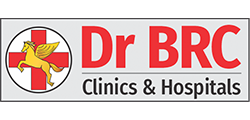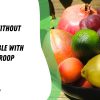The analogy of health being associated with food, exercise, sleep, stress management, and repeated medical checkups has been a dominant perception. The medical checkups pertain to various organs like the heart, kidney, lungs, blood, and many more parameters based on which health diagnosis, prevention, reversal, and cure strategies have been told to you. However, amidst this, the crucial element often overlooked or missed by us is the role of what can be considered the ‘Second Heart.
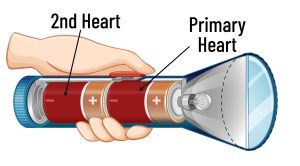
Imagine a torch with two batteries contributing equally to light the bulb. When the light doesn’t work or dims, the immediate thought is to change the batteries. But what if we focus solely on changing one battery and assume that the second one doesn’t exist? That would be half-baked knowledge.
This is akin to the oversight of our ‘Second Heart when dealing with cardiovascular, circulatory, or blood-related ailments. The most important thing that you read in the previous chapters is to circulate your blood other than your lying position while you are walking or sitting; for the blood to circulate in your body, just like both batteries of the torch, your body has two pumps one which is the heart which you always knew and the other is the second pump which you came to know after reading this book.
Your calf muscle pump gets activated the moment you get up from the bed as the movement activates the calf muscle pump.
The calf muscle pump activates when transitioning from sitting to standing or sleeping to standing. This activation of the calf muscles mirrors the role of the second heart, akin to the two batteries in a torch, contributing to blood circulation.
Exploring the concept of this second heart beyond the primary organ reveals a fascinating interplay. While lying down, organs align with the heart level, allowing the heart to pump blood efficiently. However, when we sit or stand, the heart’s position becomes higher than ground level, making blood circulation more challenging. This elevation requires more effort from the heart. Here comes the role of calf muscles-another vital pump in our body’s circulation. They activate with leg movement or fidgeting, aiding blood flow.
Unlike other animals, humans have developed the habit of prolonged sitting or standing, often due to professional obligations or a sedentary way of life.
A familiar scenario is prolonged standing during school assemblies, where the heart’s primary function is to sustain the circulatory system and counteract gravity. Here, the heart does the dual circulation job and works against gravity. Hence, calf muscles have no role in a standstill position. Approximately 20 minutes into this stance, gravity influences the circulatory system, diminishing blood flow to the brain due to increased gravitational pull on the legs. Consequently, children sometimes experience fainting spells.
However, following a fall, the heart aligns with the level of other organs, and the circulatory system typically reactivates within 5-10 minutes, restoring consciousness without needing external interventions like water or fanning.
It’s essential to share the knowledge that when an individual stands for extended periods without the ability or permission to move their legs, a simple solution exists: moving the toes or fingers inside their shoes. This action can activate the calf muscles, which are crucial in enhancing blood circulation.
Hockin BCD, Claydon VE. Intermittent Calf Compression Delays the Onset of Presyncope in Young Healthy Individuals. Front Physiol. 2020 Jan 23:10:1598. doi: 10.3389/fphys.2019.01598. PMID: 32038283; PMCID: PMC6993600.
Williams EL, Khan FM, Claydon VE. Counter pressure maneuvers for syncope prevention: A semi-systematic review and meta-analysis. Front Cardiovasc Med. 2022 Oct 13;9:1016420. doi: 10.3389/fcvm. 2022.1016420. PMID: 36312294; PMCID: PMC9606335.
By engaging the calf muscles in this manner, the circulatory system gains the ability to fight against the gravitational pull.
Wieling W, van Dijk N. Thijs RD, de Lange FJ, Krediet CT, Halliwill JR. Physical countermeasures to increase orthostatic tolerance. J Intern Med. 2015 Jan;277(1):69-82. doi: 10.1111/joim. 12249. Epub 2014 May 5. PMID: 24697914.
The prevalence of lifestyle diseases such as cancer, diabetes, and bone-related issues can be directly attributed to the inactivity of the calf muscles. The contemporary sedentary lifestyle, where individuals spend prolonged hours, approximately 9-10 hours, seated in office settings, results in inactive calf muscles. This stark correlation between mortality rates and various lifestyle-related ailments highlights the significance of keeping these muscles active.
Mayor S. Prolonged sitting increases risk of serious illness and death regardless of exercise, study finds. BMJ. 2015 Jan 19:350:h306. doi: 10.1136/bmj.h306. PMID: 25646739
To promote longevity and sustain good health, it’s imperative to enable the second heart-the calf muscles-to assist the primary heart in efficiently operating the circulatory system.
The Role of Fidgeting
In the quest for good health, pay attention to the simple act of leg fidgeting; this easy practice can bring unexpected benefits beyond diet and exercise. Regardless of your setting, whether confined to an office chair or seated in an airplane, incorporating consistent leg fidgeting proves to be remarkably advantageous for your health.
Despite its occasional social stigma or perception of bad manners, fidgeting is an activity we should encourage. It helps counterbalance the risks associated with a sedentary lifestyle. It’s essential to keep our legs in motion, whether sitting or standing, to promote our calf muscles to contribute to our circulation. Activities like foot tapping while seated provide protective benefits for leg arteries, potentially staving off arterial disease. While fidgeting might be misconstrued as a sign of distraction or rudeness, these simple movements yield significant health benefits.
We must keep our legs in motion, whether sitting or standing, for adequate blood circulation. However, any dysfunction in the legs can hinder the calf muscles’ ability to effectively pump blood despite movement, which may lead to various cardiovascular diseases in the body.
Panizzoło FA, Maiorana AJ, Naylor LH, Dembo L, Lloyd DG, Green DJ, Rubenson J. Gait analysis in chronic heart failure: The calf as a locus of impaired walking capacity. J Biomech. 2014 Nov 28;47(15):3719-25. doi: 10.1016/j.jbiomech.2014.09.015. Epub 2014 Oct 11. PMID: 25307437.
The Hidden Toll of High Heels on Calf Muscles
High heels, a staple in many wardrobes, often come with an unforeseen cost to our health. Beyond the fashionable facade lies a significant impact on the calf muscles, which can be equated to our second heart regarding circulatory function.
Walking in high heels induces a common array of venous complaints, ranging from pain and fatigue to a persistent sense of heaviness in the legs. The key contributor to these issues. is the positioning of the calf muscle-tendon unit (MTU) in a shortened state when wearing high heels. Muscles and tendons, being remarkably adaptable, undergo structural and functional modifications with chronic high heel use.
The implications extend beyond mere discomfort. The diminished function of the muscle pump due to high heels can lead to venous hypertension in the lower limbs, becoming a potential catalyst for venous disease symptoms. Therefore, the choice of footwear isn’t merely a matter of style; it directly influences the health of our calf muscles, which, as we’ve learned, play a pivotal role in our circulatory system.
Ladies high heels shoes versus Tailoring feet pedal
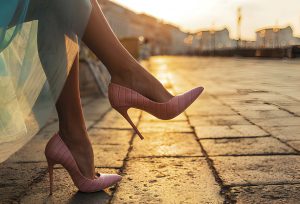
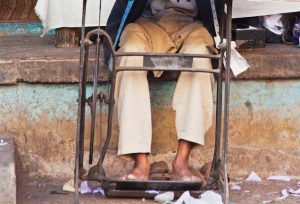
A reconsideration of the frequent use of high heels emerges not just as a style tip but as a health-conscious decision for the well-being of our second heart.
Tedeschi Filho W, Dezzotti NR, Joviliano EE, Moriya T, Piccinato CE. Influence of high-heeled shoes on venous function in young women. J Vasc Surg. 2012 Oct; 56(4):1039-44. doi: 10.1016/j.jvs.2012.01.039. Epub 2012 Apr 5. PMID: 22483354.
J. K and Pierce C (2013) Cardiomyopathy in Women: Second Heart Failure. Cardiomyopathies. InTech. Available at: http://dx.doi. org/10.5772/55433.
The Tailor’s Secret Calf Muscles and Manual Sewing Machines
Now that we’ve explored the adverse impacts of high heels on calf muscles, let’s shift our focus to a profession that inadvertently proves beneficial for your second heart – tailoring.
You might recall visiting a tailor shop and witnessing tailors operating their sewing machines with the help of foot pedals a decade ago. Naturally, a tailor’s constant footwork on the foot pedal of the sewing machine serves as a calf muscle workout, as the repetitive motion of moving the foot pedal activates the calf muscles. According to my recent observational study (see section-III), this specific exercise through toe movement is the quickest method to lower blood sugar levels.
My observational study showed that tailors tend to maintain exceptional fitness and rarely fall ill. Their blood pressure and blood sugar levels remain in healthy range, and obesity is not a concern. This remarkable health status seems linked to their consistent use of manual sewing machines. These machines, however, are now being replaced by automatic ones that operate at the push of a button. While this transition has increased productivity, it has negatively affected their longevity.
Professionals who spend extended periods sitting should regularly fidget their legs to keep their calf muscles engaged. Maintaining calf health is crucial, as vital as that of your primary heart health, in preventing cardiovascular diseases and circulatory disorders.
Measuring Your Calf Health: A Simple Experiment
To assess the health of your calf muscles, perform a simple experiment while seated. Measure your Blood Pressure (BP) and Heart Rate (HR) after the initial 15 minutes of sitting, and then re-evaluate both parameters after an additional 15 minutes. If, after 30-minutes, your heart rate has increased by more than 5 beats per minute, accompanied by a drop in blood pressure exceeding 10 mmHg during second intervals (i.e after 30 minutes), or more specifically, a diastolic BP dropping below 60 mmHg, should be considered a strong indication of inadequate fluid return to the heart, it indicates potential dysfunction in the calf muscles. This dysfunction could potentially contribute to various diseases in your body.
In short, to date, the healthcare industry has paid attention to the lungs, heart, kidneys, liver, and other body organs. Diagnostics pertaining to these body organs were developed or invented to measure health parameters or assess your health status. However, the healthcare industry wholly ignored or missed that the ‘Second Heart, i.e., calf-muscle health, is equally important as our primary heart in maintaining health.
Over the past decade, numerous research papers have delved into the concept of the ‘second heart, observing the health of hundreds of thousands of patients. These studies reveal a significant correlation between prolonged sitting and increased disease prevalence, emphasising a higher mortality rate, high morbidity, poor quality of life, and early death among individuals spending extended periods sitting down.
van der Ploeg HP, Chey T. Korda RJ. Banks E, Bauman A. Sitting Time and All-Cause Mortality Risk in 222 497 Australian Adults. Arch Intern Med. 2012;172(6):494-500. doi:10.1001/archinternmed.2011.2174
A notable 2016 trial compared two groups-one sedentary and the other sedentary but engaged in leg fidgeting often. Understandably, those who frequently moved their legs exhibited lower mortality rates and were relatively free from diseases as compared to the ones who just sat without any leg movement.
Gareth Hagger-Johnson, Alan J. Gow, Victoria Burley, Darren Greenwood, Janet E. Cade, Sitting Time, Fidgeting, and All-Cause Mortality in the UK Women’s Cohort Study, American Journal of Preventive Medicine, Volume 50, Issue 2, 2016,
Personally speaking, this act of leg movement not only improved energy level but also boosted concentration & focus, potentially due to enhanced blood flow to the brain and improved nutrient distribution to vital organs. This is achieved due to the synchronized movement of calf muscles, i.e., the second heart and the primary heart, towards blood circulation more efficiently, enhancing the higher flow of blood towards the brain and improving nutrients to body organs.
Similarly, endothelial cells, forming a lining within blood vessels, are crucial in regulating exchanges between the bloodstream and surrounding tissues. These endothelial cells regulate blood circulation by producing nitric oxide, which regulates blood pressure in your body. Dysfunction in these endothelial cells leads to various diseases. Fidgeting emerges as an effective preventive or curative measure against endothelial dysfunction.
Prolonged sitting-induced leg endothelial dysfunction is prevented by fidgeting. Takuma Morishima, Robert M. Restaino, Lauren K. Walsh, Jill A. Kanaley, Paul J. Fadel, and Jaume Padilla. American Journal of Physiology-Heart and Circulatory Physiology 2016 311:1, H177-H182
Notably, fidgeting can increase energy expenditure by 50% compared to being sedentary.
James A Levine, Sara / Schleusner, Michael D Jensen, Energy expenditure of nonexercise activity. The American Journal of Clinical Nutrition, Volume 72, Issue 6, Dec 2000.
Also, extended periods of sitting (without leg movement) lead to blood and fluid accumulation in the lower limbs, commonly observed in chronic kidney patients. These patients often exhibit swollen hands and limbs, reduced urine output, weakness, breathlessness and elevated blood pressure-classic symptoms of chronic kidney disease patients and kidney failure. However, activating the calf muscles pump through fidgeting can significantly help alleviate these symptoms, as indicated by research findings in this 1989 research paper.
Stick, C., Grau, H.; Witzleb, E. On the edema-preventing effect of the calf muscle pump. Europ. J. Appl. Physiol. 59, 39-47 (1989). https://doi. org/10.1007/BF02396578
This means patients undergoing dialysis, especially those with chronic kidney issues or oedema, should seriously consider adopting the habit of leg fidgeting while seated, as demonstrated in the research literature. The degree of calf muscle pump activity while awake significantly correlates with longevity-a reduced activation leads to a decrease in lifespan and vice versa.
Activating your calf muscles plays a significant role in your longevity. Ensuring regular activation, you equip yourself with a powerful tool to prevent and reverse various diseases. Cultivating a habit of fidgeting can effectively contribute to this. Over time, you’ll notice a normalization of your blood pressure and blood sugar levels and an increase in your energy levels.
Consider making a New Year’s resolution to promote the practice of fidgeting. Ensure fidgeting on and off. Make it a part of your behavior. It’s a cost-free method that significantly contributes to maintaining good health.
As breathing comes naturally, fidgeting should also be developed like an inherent habit. Practice it on and off. Set reminders to fidget. Let your brain get accustomed to fidgeting so much that you start doing it automatically. Once you do this, you will observe that your blood sugar starts normalizing, your BP starts normalizing, your energy levels start improving, your pain starts reducing, and many other medical conditions worsening your life will start improving.
Hence, ‘fidget’ your way to optimal health and well-being. Let it be a part of the office rule or an integral part of flight safety protocols, which the air hostess demonstrates to the onboard travelers. Let them encourage or remind you to fidget as much as possible so that your calf-muscle pump remains activated and the damage caused to the body, specifically to heart or kidney, due to long hours of sitting during office or travel, can not only be mitigated but also alleviate or reverses these medical conditions gradually.
Spread the message of fidgeting as much as possible to benefit everyone. Let this be a new mantra to maintain your health ‘Fidget your way to good health’!
I often distribute the “2nd heart trainers (puppet)” to my patients and friends, which I recommend them to keep on their workstation. It serves as a constant reminder to fidget their legs while sitting which helps in developing leg fidgeting as a habit.
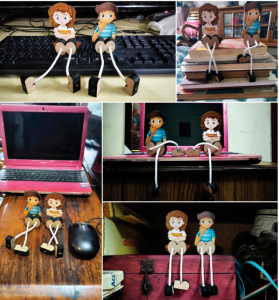
Conclusion
In pursuing wellness, we often concentrate on familiar avenues like diet and regular medical checkups. However, an often-overlooked aspect that plays a pivotal role in our overall health is the often-underrated “second heart” Beyond the traditional health parameters, envision the body as a well-calibrated system where this secondary powerhouse-akin to a silent partner-holds profound significance in cardiovascular health and overall well-being.
Calf Muscles: The Overlooked Heroes: Exploring beyond the primary organ-the heart-reveals an intricate interplay where calf muscles, activated by leg movements, contribute significantly to our circulatory system.
The Sedentary Lifestyle Dilemma: In today’s sedentary lifestyle, prolonged sitting or standing challenges our circulation. This underscores the importance of continuous leg movements for maintaining optimal blood flow.
Fidgeting: The Unrecognized Solution: Despite being perceived as a distraction, continuous leg fidgeting while seated offers immense health benefits, countering the risks associated with prolonged inactivity.
Professions and Leg Movement: Certain professions necessitate constant leg movement, impacting calf health positively. Conversely, modern advancements affecting leg movement have adversely affected individuals’ well-being.
Measuring Calf Health: A simple seated experiment can gauge calf muscle health, highlighting potential dysfunctions that might contribute to various diseases.
Research Insights: Studies have correlated prolonged sitting with increased disease prevalence, while continuous leg movement surprisingly lowers disease incidence, enhancing both circulation and cognitive focus.
The Power of Fidgeting: Fidgeting emerges as a preventative measure against endothelial dysfunction and significantly aids in alleviating symptoms related to chronic kidney issues or oedema.
As we navigate various avenues in the pursuit of optimal health, the vitality of the ‘Second Heart‘ and the significance of continuous leg movement take center stage. It’s time to recognize the critical role calf muscles play in our physiological orchestra, embracing fidgeting not just as a habit but as a cost-free and efficient method to foster enduring well-being. Integrating this awareness into our daily routines marks a transformative step toward fostering holistic health.
For More Updates Join Our Social Media Platforms
Stay connected with us for daily health tips, DIP Diet updates & Dr. Biswaroop Roy Chowdhury Video.
